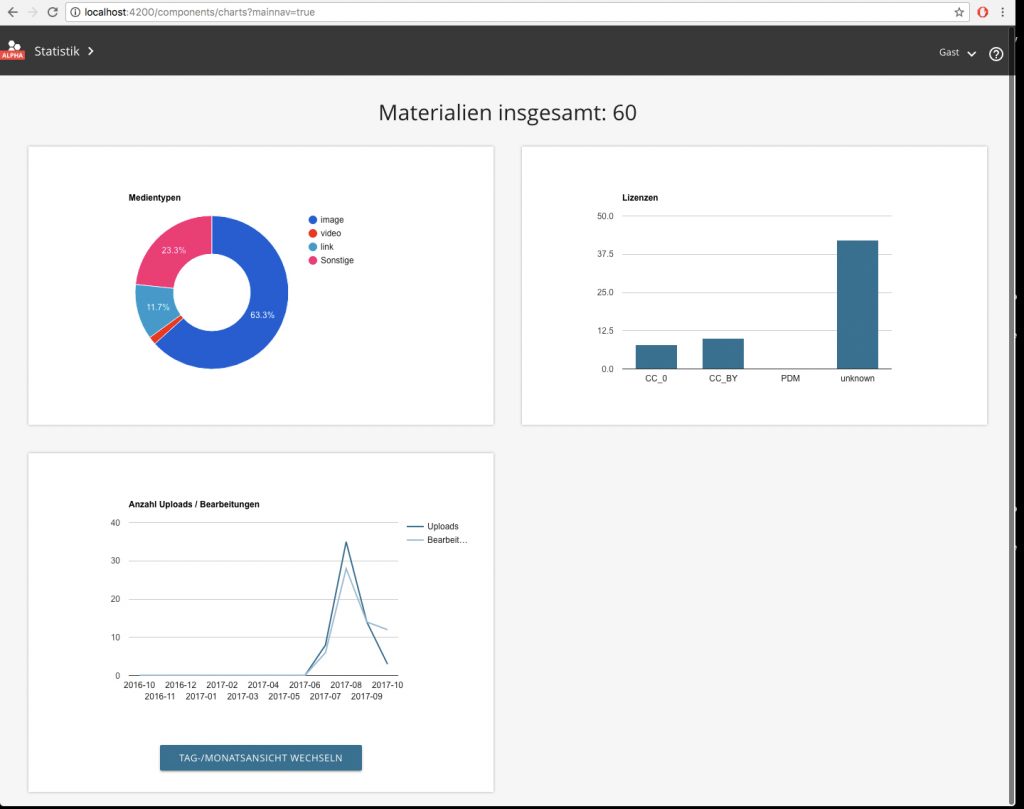edu-sharing 4.0: Released Candidate has been published – test environment stays open
5. October 2017edu-sharing Hackathon september
26. November 2017Working on information services of OER repositories at edu-sharing hackathon
The edu-sharing developer team has worked on an OER (free learning material) information service of repositories at the monthly Hackathon in October and has developed concepts and a first partial solution. We would like to discuss this in the OER-Community and develop solutions together.
An optimal result would be if:
- every learning platform that contains OER
- each authoring tool, with which OER are created and
- any system that manages OER (such as repositories, like edu-sharing)
would provide such an information service. In addition, systems where users search for learning material, should retrieve this information and offer this to their user. Such information should be aggregated in central portals, for example the OER-Worldmap.
Many thanks to the team of the OER-Worldmap, who today shared their knowledge and implementation tips during spontaneous inquiries.
Why should OER repositories and other systems provide informations?
For OER to be used and developed further, they must first be discoverable. Therefore numerous developers and operators of OER portals, OER repositories, learning platforms and authoring are working together.
Recently, the international OER community also underlined the need to further promote the retrievalability of OER. The Ljubljana OER Action Plan 2017 (PDF), which was adopted in September for the 2nd OER World Congress, recommends the following measures:
Finding OER
i) Index OER resources to support the identification of existing OER. This would include improving search and discovery of OER by supporting the sharing of OER meta-data (subject matter, licensing , language, institution, region, level of education, etc.) among OER content providers and search tools;
j) Develop and maintain sustainable measures for the interoperability of platforms for sharing OER that support usage and are sustainable.
For the concrete implementation of the measures, in addition to politics, among other things, Decision makers of the individual countries, we asked OER-active, especially the developers of software systems for OER.
What does such an OER information service do?
Used as an OER repository, edu-sharing already has interfaces that can be used to exchange metadata. This allows external portals or repositories to retrieve the contents stored in edu-sharing. In the opposite way, external content can be collected for edu-sharing users. The edu-sharing operator (the educational organization or the state) decides whether and which content is provided or collected.
However the prerequisite for such an exchange of metadata – and subsequently the learning materials themselves – is, that the own repository is known. So systems that search for metadata need to find this “retrieval possibility”.
Each repository should have a kind of business card. Such business cards could be retrieved from portals, such as the OER Worldmap. These portals create an overview of existing “services” and present it – in this case at a map. There are several such information and metadata aggregating portals. These business cards shall reach these portals automatically so without forcing operators to keep them manually up-to-date.
The aggregating portals could provide a function in which repository operators manually type in just minimal data, for example only the link to the business card. The business card itself is then offered by the own repository on an interface and kept up-to-date locally. The OER Worldmap portal can then pick up the entire business card and enter it into their Map of the OER content sources and update the news from time to time automatically by using the repository interface. Further this information on the existence and the location of content sources could be spread even more easy, if in turn such aggregating portals offer interfaces with the sum of all collected information to other systems.
In addition to a business card, information aggregating portals should collect statistical information about the content sources, such as the number of content and their frequency of use. For this purpose, an information service of the repository has to provide and maintain appropriate statistical information.
So an information service of a repository should have at least the following three parts:
- business card
- on the Repository (name, place, operator, …)
- about the offer (target group, subject area, used licenses, …)
- information about offered exchange interfaces
- Statistical information
- Number and type of content in the repository
- Number and type of users (OER vs. other – or – pure users vs. authors vs. quality assurance)
- Usage intensity (per period: active users and their activities, eg use, creation, publication of OER)
- Metadata exchange interface
- for harvesting and federated search of other systems (e.g., OAI-PMH as interface and LOM as format)
- for search engines (e.g., sitemaps as an interface and LRMI as format)
An information service should offer 2 forms
- Interfaces that can be accessed automatically from other systems
- Human interface
So far the information service for repositories has been described. However, all initially mentioned systems which contain OER or their metadata, should implement such information services (Learning Management Systems, Authoring Tools).
What has been developed at the edu-sharing Hackathon?
A first concept and a first initial solution has been developed at today’s Hackathon, as well as analyzes and concepts parts for further discussions and solutions in the community.
The results at a glance
- API extension for the information service
- human interface for statistical data
- Target group analysis: Who is interested in which (statistical) data of a repository
- Discussion of a possible data structure for a business card with basic statistics
- Review of possible usable standards
![]() This text is licenced under the CC BY 4.0-Licence. Author: Annett Zobel (edu-sharing)
This text is licenced under the CC BY 4.0-Licence. Author: Annett Zobel (edu-sharing)

